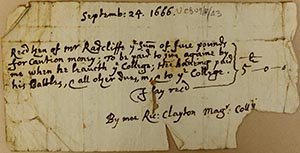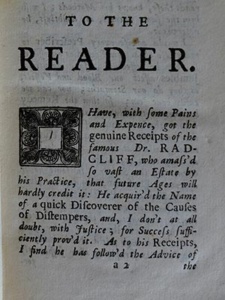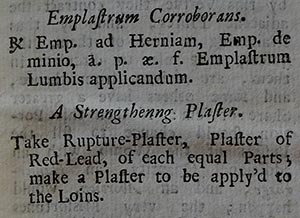Less study & more exercise
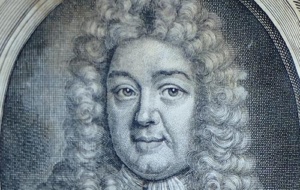 This month we’re exploring a book with connections to one of Oxford and Univ’s great benefactors, Dr John Radcliffe. You can’t go far in the city without encountering a building or institution bearing the name “Radcliffe” – the Radcliffe Camera, Radcliffe Observatory, Radcliffe Infirmary, and Univ’s own Radcliffe Quad. All of these were established through Radcliffe’s substantial legacy, his fortune arising from his medical practice in Oxford and later in London. His clients included aristocrats, academics, writers, and royalty, such as Sir Thomas Spencer, the Duke of Beaufort, Sir Isaac Newton, Jonathan Swift, Alexander Pope, King William III, and Queen Anne.
This month we’re exploring a book with connections to one of Oxford and Univ’s great benefactors, Dr John Radcliffe. You can’t go far in the city without encountering a building or institution bearing the name “Radcliffe” – the Radcliffe Camera, Radcliffe Observatory, Radcliffe Infirmary, and Univ’s own Radcliffe Quad. All of these were established through Radcliffe’s substantial legacy, his fortune arising from his medical practice in Oxford and later in London. His clients included aristocrats, academics, writers, and royalty, such as Sir Thomas Spencer, the Duke of Beaufort, Sir Isaac Newton, Jonathan Swift, Alexander Pope, King William III, and Queen Anne.
Radcliffe was renowned for his diagnostic skill and sensible treatments (for the time), notably for successful treatment of smallpox. He was in demand with wealthy clients, earning twenty guineas a day within a year of setting up practice in London. However, he could be forthright in his opinions and blunt in his manner, which eventually lost him the favour of his royal patients. For Alexander Pope, he prescribed “less study and more exercise”!
John Radcliffe was born in Wakefield, Yorkshire. The exact year of his birth is uncertain, either 1650 or 1652. He matriculated at Oxford in March 1666, entering Univ where he was mentored by fellow and tutor, Obadiah Walker (later Master from 1676 to early 1689). A lasting friendship developed between Radcliffe and Walker. When Walker, a Catholic, fell on hard times after losing his position as Master following the abdication of James II, Radcliffe helped him. Walker eventually lived with Radcliffe, before dying in 1699.
There’s little in the Univ archive about Radcliffe’s time in College, apart from a receipt, dated September 24th, 1666, for five pounds of caution money. It is signed by Thomas Clayton, Master. Caution money was a payment up front against any debts incurred by students during their studies. Once any debts were settled, the remaining money was returned.
Radcliffe took his BA in 1669, moving to Lincoln College in 1670, where he studied for his MA and Batchelor of Medicine, graduating in 1675. He remained at Lincoln College while starting to practice medicine. He had to resign from his fellowship in 1677 because he refused to take holy orders and was unsuccessful in securing a faculty position, which would have excused him from being ordained. He continued as a medical practitioner in Oxford, taking the Doctor of Medicine degree in 1682. With an established reputation for good diagnosis and treatment, Radcliffe moved to work in London in 1684. He never married and made careful provisions about how his wealth was to be passed on after his death, primarily in bequests to the University of Oxford and University College. After his death in 1714, Radcliffe’s net estate was valued at around £126,000, equivalent to about £19.8 million today. He was specific in his will about funding a library for the university (the Radcliffe Camera) and “the building (of) the front of University Colleg in Oxon down to Logic Lane answerable to the front allready built and for the building of the Masters lodgings therein”. Radcliffe was a generous donor to Univ in his lifetime as well. For example, in 1693 he gave over £1000 for financial support and books for poor scholars, in response to an appeal by the master, Dr Arthur Charlett.
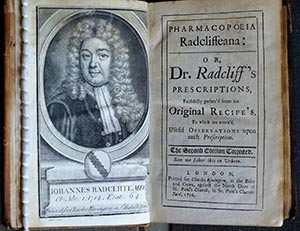
Figure 2: Opening pages of “Dr. Radcliff’s Prescriptions” with an engraving of Radcliffe on the left-hand page. (Click for larger image)
Despite his success as a physician, John Radcliffe did not write any medical text in his lifetime. Univ Library has a copy of “Dr. Radcliff’s Prescriptions” which recently returned to college after long-term loan to the Museum of the History of Science. Although it has Radcliffe’s name in the title, it was published in 1716, two years after his death. It is a collection of prescriptions, or medicinal recipes.
“Dr. Radcliff’s Prescriptions” was published in two parts. In the Univ copy, both parts have been bound in a single duodecimo volume. The book is quite fragile, which means we’ve been limited in what we can photograph for this article. Part one contains collected prescriptions, presented in Latin and English, with remarks by an anonymous author after each one. The preface to part one opens with the statement “I have, with some Pains and Expense, got the genuine Receipts of the famous Dr. RADCLIFF, who amass’d so vast an Estate by his Practice, that future Ages will hardly credit it.” Anonymous publication was not unusual at the time. The author had evidently received criticism concerning the authenticity of the prescriptions. At the end of the preface, he writes “The Recipe’s in this Part have been much cry’d down by many: First, Because they are look’d upon not to be genuine: And in the next Place, because they are in English. But I challenge any Assaylant to make it appear, that they are not the Doctor’s individual Receipts.” We can imagine the lively debate amongst the medical profession in the coffee houses of early eighteenth-century London.
Part one sold well. According to the preface to part two: “in less than six months above Sixteen Hundred have been sold off, so that a Second Impression was undertaken in less than Three Months”. This suggests people were keen to learn something of John Radcliffe’s success in a very competitive profession. The author remained anonymous in part two, writing “I have been press’d by a certain Gentleman to prefix my Name to the Book, which I shall not, for his sake deny, when a proper season offers.” To support the veracity of the prescriptions, and possibly because of further criticism, the author acknowledges “my friend Mr. Trevor M.L. who obtain’d for me a large file of the Doctor’s Recipe’s; and if any doubt of the Sincerity of the Author in Transcribing them, Mr. Trevor is ready to satisfy them as to that point.” Part two contains more prescriptions with the author’s observations, followed by a hefty appendix with even more prescriptions and observations collected by the author from his own practice and other sources.
The prescriptions are recipes for oral medicines, pills, plasters, and ointments, with short directions for how they were to be taken. John Radcliffe probably wasn’t the originator of all the prescriptions. Rather, he would have used and adapted existing remedies he considered appropriate through his diagnostic skill and experience. Physicians rarely dispensed the medicines they prescribed. Prescriptions were made up by an apothecary, and an apothecary working with a noted physician like Radcliffe could have a very lucrative business. There was professional rivalry between physicians and apothecaries, arising after the Great Plague of 1665, when apothecaries stepped in to care for the sick when many physicians fled London. Fortunately, Radcliffe remained on good terms with his main apothecaries James Saint-Amand, John Dandridge and Charles Jenner.
Common curious ingredients include red coral, pearl, crabs’ claws, and crabs’ eyes. Most of the other ingredients are botanical. Some prescriptions include opiates, although the author is at pains to advise caution in their use. An alarming ingredient to modern eyes is red lead (lead tetroxide, Pb3O4). It is given in a prescription for a plaster to be applied to the loins to reduce the risk of miscarriage. The author is sceptical about its efficacy, while not being aware of the toxicity of lead compounds. At least this recipe was for a plaster applied to the skin, rather than something taken orally.
Although it’s best not to judge the prescriptions against modern standards, some ingredients have known medicinal properties. Bark of Peru (the bark of species of the genus Cinchona) is mentioned in a treatment for fever. It is a source of quinine, which was later found to be effective in the treatment of malaria. There’s a modern connection to malaria in another ingredient, Roman Wormwood (Artemesia pontica), which appears several times in the prescriptions. As its name suggests, it was used to treat intestinal worms, and was also used in prescriptions for digestive problems or to reduce pain and swelling. In 2015, Tu Youyou won the Nobel Prize in Physiology/Medicine for her discovery of the anti-malarial compound artemisinin, extracted from the wormwood species Artemisia annua. Since her work received such recognition, there’s been renewed interest in the pharmacology of compounds extracted from wormwoods.
Picking one prescription to look at in more detail, we note John Radcliffe’s reputation in the treatment of smallpox. He rejected the accepted method of shutting the patient up in a hot, stuffy room, instead advising plenty of fresh air and cooling emulsions. The prescription is for an ointment for smallpox blisters, which after scabbing over could leave disfiguring scars – hence the term “pockmarked.”
Ointment of Sperma Ceti
Take of Sperma Ceti, Orange-Flower-Butter,
white Wax, of each 2 Drams; Oil of sweet Almonds a little;
mix and make an Ointment.
The author notes “When the Small-Pox begin to Scab, and are in Danger of making Escars on the Face, this rubbed on, softens the Scabs, and loosens them from the Parts subjacent; and thus falling off early without any Pain, the Skin neither keeps so long red under, nor the Scars so much dimpled;”
Sperma Ceti (spermaceti) is a waxy substance found in large quantities in the head of sperm whales. It was obtained and processed by the whaling industry for use in cosmetics, pharmaceuticals, lamp oil, lubricants, and candles. It would have been an expensive ingredient in Radcliffe’s time, and thankfully most whaling is now prohibited by international treaty.
Who was the anonymous author so keen to collect, annotate and publish the prescriptions? There’s a clue in an advertisement placed at the end of Part One and Part Two. It’s common today to see adverts for other books at the end of a modern paperback – the practice isn’t new! It starts: “Just Publish’d, with the Approbation of the College of PHYSCIANS: Criticon Febrium, Or, a Critical Essay on Fevers, with the Diagnosticks, and Methods of Cure, in all the different Species of them.” The author was “Edward Strother M.D.” who has also been identified as the probable author of Dr. Radcliff’s Prescriptions. While remaining anonymous for our book, Edward Strother was not averse to using it to promote one of his other works. Today, Strother should be considered as an editor or contributor, rather than the author, as is noted for a copy or part one in the British Library.
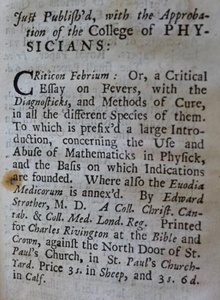
Figure 5: Advertisement for “Criticon Febrium” by Edward Strother, at the end of part one of “Radcliff’s Prescriptions”(Click for larger image)
It’s been lamented that John Radcliffe didn’t publish in his lifetime, however he set the tone for future medical progress by challenging established practices like bloodletting, preferring to prescribe treatments that worked, or at least did no harm. Perhaps this is an early example of evidence-based medicine? A far greater legacy than a book is the entire library he endowed in the form of the Radcliffe Camera, Univ’s Radcliffe Quad and other fine buildings we can see around Oxford. The Radcliffe Trust, established by his will, exists to this day, and continues his charitable bequest. Currently, the trust offers financial support through two schemes, one for music and the other for heritage and crafts.
A final thought, as we approach the long vacation, is that we’ll have the opportunity over the summer to follow John Radcliffe’s prescription of “less study and more exercise”!
Bibliography
John Radcliffe (1650-1714), Pharmacopoeia Radcliffeana: or, Dr Radcliff’s Prescriptions, faithfully gather’d from his Original Recipe’s. To which is annex’d, useful Observations upon each Prescription (London: Charles Rivington, 1716), ¬R.2.19.
References
David Cranston, John Radcliffe and his Legacy to Oxford (London: Words by Design, 2013), KBA/CRA.
Ivor Guest, Dr. John Radcliffe and his Trust (The Radcliffe Trust, 1991), KCA/RAD,G
Campbell R. Hone, The Life of Dr. John Radcliffe 1652-1714 (London: Faber & Faber, 1950), KCA/RAD,H
John Radcliffe (1650-1714), Pharmacopoeia Radcliffeana: or, Dr Radcliff’s Prescriptions, faithfully gather’d from his Original Recipe’s. To which is annex’d, useful Observations upon each Prescription [by Edward Strother]. British Library General Reference Collection DRT Digital Store 547.c.21.
Bank of England Inflation Calculator, retrieved 13 June 2023, See bankofengland.co.uk
The Nobel Prize – Women Who Changed Science – Tu Youyou, retrieved 19 June 2023, see nobelprize.org
The Radcliffe Trust, retrieved 19 June 2023, See theradcliffetrust.org
Further selected Univ Treasures are detailed below or explore the whole collection on our News and Features Treasures pages.
Published: 23 June 2023

